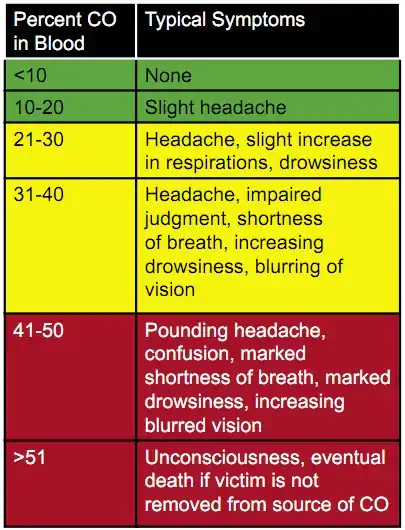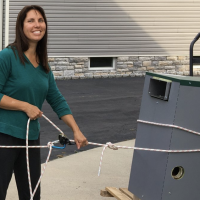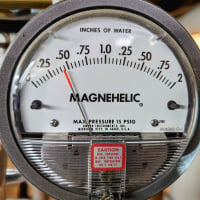Low level Co exposure

Hi. Can anyone direct me to an article, showcasing the risks of long-term exposure to low levels of carbon monoxide? Thanks
Comments
-
-
All you need is Captain CO's email..Jim Davis has articles on CO going back to the 1960s when he came back from The 'Nam. Hopefully he'll see this. If not, DM me & I'll connect you with him mad Dog
0 -
I need something that I can show customers. Plain simple English. Not too long. And from what they would consider someone reputable. Like the CDC or some reputable medical organization.....
0 -
-
-
Thanks.
0 -
I think he’s looking for long term exposure, i.e what happens at certain ppm levels over weeks, months, years.
0 -
-
long term CO Exposure !
0 -
You might also try a somewhat unlikely source (until you think about it): the FAA Medical office. We who fly tend to worry about CO…
Br. Jamie, osb
Building superintendent/caretaker, 7200 sq. ft. historic house museum with dependencies in New England0 -
The medical community has, thus far, pretty much ignored CO. There is a dearth of information on it. Aside from a smattering of papers and studies, consider these points:
CO is a poison
It binds up hemoglobin so it cannot transport oxygen to every cell in the body. Therefore, you begin to get cellular suffocation.
COHb does not help remove the metabolic waste piling up at the curb so to speak. The lactic and pyruvic acid must be cleared by the other pathways resulting in metabolic acidosis.
Listed CO alarm alert algorithms are based off COHb for a smoker- 10%. UL and the great minds of the world are ok with you living day in and out at just under 10% COHb indefinitely.
God designed your cells for a specific oxygenation-At 760 mmHg or torr PO2 your PaO2 runs about 100mmHg O2 normally at rest. Venous CO2 runs btw 30-40mmHg. The resilience of the human body is limited. You can hold your breath for a few minutes. Your body suffers biological death of cells after about 4-6 minutes of cardiac standstill.
They're learning more as we go. The myoglobin in your blood and muscles store CO.
It has limited short term beneficial effects at times in the body, which is why we produce tiny amounts of endogenous CO (in the body) but exogenous CO is harmful. There is no good way to measure, either quantitatively or qualitatively the harm from CO but consider this: All poisoning is dose over time. The longer the body's cells are exposed, the more damage- period. That's all anybody needs to know to appreciate the hazard and the need to prevent, detect, and eliminate.
1 -
Define your goal here: Are you trying to sell CO monitors? Are you trying to sell Combustion analyzer use? What I've found that is much more relatable to the common person is a collection of newspaper articles on CO poisoning & deaths. You could compile them.in a pdf file. They are so plentiful & frequent!v It doesn't take long to gather them.
99% of people's eyes glaze over after the first sentence when you're trying to 'splain the finer points. Mad Dog
0 -
-
I don't know about the medical industry as a whole, though I suspect that your local GP may have other things to worry about. I can assure you that at least one subset of the "medical industry" is not ignoring it, as I mentioned above: low level CO exposure is a matter of considerable concern to the aviation industry, and a good deal of thought has gone into both guidelines — and equipment to measure exposure and evaluate low level effects. That said, however, aviation as a whole is not a field which welcomes scare 'em to death journalism, so it doesn't get much press unless something goes seriously wrong — and then getting reliable coverage is pretty hopeless.
Br. Jamie, osb
Building superintendent/caretaker, 7200 sq. ft. historic house museum with dependencies in New England0 -
NJ Steam Homeowner.
Free NJ and remote steam advice: https://heatinghelp.com/find-a-contractor/detail/new-jersey-steam-help/
See my sight glass boiler videos: https://bit.ly/3sZW1el0 -
Where are the multitude of peer reviewed studies that interfaced building science, demographics, public health, personal health histories, etc. with our daily growing knowledge of physiology that keeps proving just how much we don't know. We know what we know based upon the limited information available. When no one seems to grasp the interrelated disciplines and more above, you get a partial picture. Partial pictures kill hundreds of thousands every year.
How many recent studies have you seen on the various factors that affect uptake of CO at the aveolar level based upon various partial pressure gradients then which other known factors, such as the bicarbonate system, can affect COHb blood levels? What are the beneficial effects of endogenous CO in the body with certain conditions and processes.
Why do not fire departments routinely test 100% of all fire victims for COHb?
Why do not EMS test 100% of ALL patients for COHb? Emergency room admissions? Hospital admissions? Doctor's offices?
Why is it fire depts do not report CO deaths unless they are told there are victims of smoke inhalation ? How many people die of "natural causes" when really it is CO or CO was a complicating factor? We don't know because the reporting systems are a joke. Therefore, the medical community has almost no visibility of the scope of the problem. You demonstrate how widespread the problem is and how to make money off it and you will see people coming out of the woodwork to jump on it.
0 -
Ok so who are we getting information from regarding all of this?
Single pipe 392sqft system with an EG-40 rated for 325sqft and it's silent and balanced at all times.
0 -
-
-
-
I have worked with toxicologist for 20+ years, Recent reports from WHO are now saying levels as low as 3-5 ppm can cause long term illness or disabilities. I am currently working with a Carbon Monoxide Coalition that is putting together training for firefighters, They were shocked how many fireman get CO poisoned. I think you can look up Albert Donnay from Maryland Univ and get more CO info. We do have a list of CO affects but I am not sure that is downloadable. Might be on Alberts site.
Just for the record. almost ever person has exposure to unwanted CO, but because the symptoms are not immediate we ignore them. when I see contractors say they don't test, I see fessionals not pros~ (jimd@ncihvac.com)
1 -
-
Levels near properly adjusted gas stoves are often 5 to 15 ppm
So I guess you are all behind the electrification movement?
NJ Steam Homeowner.
Free NJ and remote steam advice: https://heatinghelp.com/find-a-contractor/detail/new-jersey-steam-help/
See my sight glass boiler videos: https://bit.ly/3sZW1el1 -
"Levels near properly adjusted gas stoves are often 5 to 15 ppm So I guess you are all behind the electrification movement?" …
Hi, It's been found that asthma rates for children who live with gas stoves is 42% higher than for those who don't. I think this was a Lawrence Berkeley Labs study some years back. If we installed and used range hoods correctly, this wouldn't be such a problem. So, what are the best options for keeping people healthy?
Yours, Larry
1 -
-
-
So,
All stoves / ovens should have a half way decent outside vented fan?
Besides stink,smoke and oil that just comes from normal cooking that justifies one all by it self....
I like a 400+ cfm fan over my stove. Variable is also necessary.
Single pipe 392sqft system with an EG-40 rated for 325sqft and it's silent and balanced at all times.
1 -
below is an excerpt from a medical journal article citing epidemiological studies looking for elevated problems on a population basis for long term low level exposure.
to summarize, they noted some elevation, but the signal is sort of clouded when you adjust for other airborn polutants such as pm 10, pm 2.5, (fine particulate matter that crosses into the blood in the lungs) and oxides of nitrogen.In the case of CO from poor venting with hvac equipment those other pollutants are likely to be spilling in addition to CO….
https://www.ncbi.nlm.nih.gov/books/NBK153687/
“Several multi-city studies have found significant associations between increasing short-term average ambient air carbon monoxide concentration and increasing mortality risk when carbon monoxide is considered in single-pollutant models, with the associations attenuated when models were adjusted for other co-pollutants. A time-series study examined mortality in 82 U.S. cities during the period 1987–1994 (Dominici et al. 2003b; HEI 2005; Samet et al. 2000). In the Dominici et al. (2003b) analysis of these data, a 1 ppmincrease in ambient air carbon monoxide concentration (lag 1 day) was associated with increased mortality (from all causes) of 0.46% (95% CI: 0.18, 0.73). Mortality risk was not significant after adjustment for air concentration of PM10
alone or for PM
10
and NO
2
. A time-series study examined morality in 12 Canadian cities during the period 1987–1994 (Burnett et al. 2004). Mortality risk (all non-accidental causes) was significantly associated with ambient air carbon monoxide concentration (lag 1 day) in single-pollutant models, with an increase of 0.68% (t=3.12) per 1.02 ppm increases in air carbon monoxide concentration. However, the association did not persist when adjusted for NO
2
(0.07%, t=0.30). A time-series analysis examined mortality in 19 European cities during the period 1990–1997 (Samoli et al. 2007). This study found a significant association between carbon monoxide and total non-accidental and cardiovascular mortality in single-pollutant models. The estimated effect size varied depending on the model applied. The effect size for total mortality based on a single-pollutant model ranged from 0.59% increase (95% CI: 0.41, 1.79) to 1.20% (95% CI: 0.63, 1.77) per 1 mg/m
3
increase in carbon monoxide concentration (0–1-day lag). The effect on cardiovascular mortality ranged from 0.8% increase (95% CI: 0.53, 1.07) to 1.25 (95% CI: 0.30, 2.21). Inclusion of black smoke or NO
2
in the models substantially decreased the estimated risk attributable to carbon monoxide, with the effect sizes no longer significant in some models.”
1 -
There are… the reports cited above are interesting. And, like most such reports, need to be read with care and understanding.
Probably the most important point in them is the phrase (said variously): "Inclusion of black smoke or NO in the models substantially decreased the estimated risk attributable to carbon monoxide, with the effect sizes no longer significant in some models.”
Or, in plain language: An effect of [low level] CO can only be discerned when it is the only contaminant studied. Which, folks, it never is in real life.
Br. Jamie, osb
Building superintendent/caretaker, 7200 sq. ft. historic house museum with dependencies in New England2 -
“Probably the most important point in them is the phrase (said variously): "Inclusion of black smoke or NO in the models substantially decreased the estimated risk attributable to carbon monoxide, with the effect sizes no longer significant in some models.”
Or, in plain language: An effect of [low level] CO can only be discerned when it is the only contaminant studied. Which, folks, it never is in real life.”
I suspect if CO is spilling into the living space, oxides of nitrogen and fine particulate matter are spilling into the house along with it…1 -
All these studies make my point- there are NO comprehensive studies that encompass all the major disciplines not limited to but including: building science, mechanical systems, combustion appliances, alternative sources of CO, weather and climate, physiology, demographics, lifestyles, etc.
One major sub-unit is to better understand CO's uptake, effects, concomitant effects, mitigating factors, clearance, and co-mortality and co-morbidities from a medical standpoint. What about the testing efficacy and reliability? Other than venous blood testing using a blood gas analyzer or pulse oximetry what other possible screening modalities would make it more commonly available, such as real time on your smart watch? What are sources of endogenous CO, how are they activated, and why is it being produced? Is there some benefit of CO for certain conditions?
Another is CO in structures: production, pathways into the ambient air, movement through structures, outdoor CO infiltration modalities, indoor CO exfiltration routes and strategies, detection and warning levels and response times, does anything mask CO, what other markers may help ?
1 -
Are there cases where CO is present without NOx?
0 -
Here is a study of CO in submarines. Its critical that the CO is monitored and kept as low as possible in recirculation systems. Didn't read through the whole thing but they may have details on the studies findings.
0 -
-
Understood, Steam Doctor. You're a Mensch..no doubt. That being said, have you studied under the great Jim Davis? Catch him while you can..Mad Dog
0 -
I have not. Probably should. Can you send me his info? Thanks
0 -
True story. I was working a few years ago in the house of a relatively young widow. Her husband had died from heart disease. I knew them loosely as acquaintances as well. Have zero access to any medical info. This was shortly after I started wearing a personal CO detector on my belt. I was working on the boiler. Something with the controls if I remember correctly. Some point I hear a beep beep beep... Took a few seconds to register. First thought was that I'd cut through an alarm wire or something like that. Has happened before. Then I realized that my co monitor was beeping. I'm like that doesn't make any sense, the boiler has been off for a long time. Then I take a look at the water heater and I see that the flue pipe is not connected and the draft Hood was venting into the Boiler room. I realized instantly what had happened. There was a shyster of a contractor, who had disconnected the flu pipe to tee into the hot water pipe. And had forgotten to put the flu pipe back on the draft Hood. Carbon monoxide has been spilling into that house for approximately 5 years. I have no idea if that was connected to this fellow's heart problems or not, but one needs to wonder. I had a somewhat similar story with a young cancer survivor. So this has been sort of a personal war for me, but it is near impossible to get anyone to listen.
2 -
just take one step at a time
0 -
Categories
- All Categories
- 87.3K THE MAIN WALL
- 3.2K A-C, Heat Pumps & Refrigeration
- 61 Biomass
- 427 Carbon Monoxide Awareness
- 119 Chimneys & Flues
- 2.1K Domestic Hot Water
- 5.8K Gas Heating
- 114 Geothermal
- 165 Indoor-Air Quality
- 3.7K Oil Heating
- 76 Pipe Deterioration
- 1K Plumbing
- 6.5K Radiant Heating
- 395 Solar
- 15.6K Strictly Steam
- 3.4K Thermostats and Controls
- 56 Water Quality
- 51 Industry Classes
- 50 Job Opportunities
- 18 Recall Announcements












